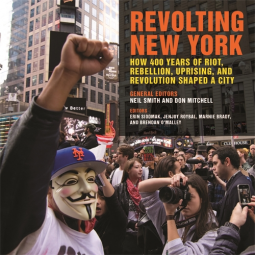
Revolting New York
How 400 Years of Riot, Rebellion, Uprising, and Revolution Shaped a City
by Edited by Neil Smith and Don Mitchell
This title was previously available on NetGalley and is now archived.
Send NetGalley books directly to your Kindle or Kindle app
1
To read on a Kindle or Kindle app, please add kindle@netgalley.com as an approved email address to receive files in your Amazon account. Click here for step-by-step instructions.
2
Also find your Kindle email address within your Amazon account, and enter it here.
Pub Date Apr 01 2018 | Archive Date Jul 02 2019
Description
Occupy Wall Street did not come from nowhere. It was part of a long history of riot, revolt, uprising, and sometimes even revolution that has shaped New York City. From the earliest European colonization to the present, New Yorkers have been revolting. Hard hitting, revealing, and insightful, Revolting New York tells the story of New York’s evolution through revolution, a story of near-continuous popular (and sometimes not-so-popular) uprising.
Richly illustrated with more than ninety historical and contemporary images, historical maps, and maps drawn especially for the book, Revolting New York provides the first comprehensive account of the historical geography of revolt in New York, from the earliest uprisings of the Munsee against the Dutch occupation of Manhattan in the seventeenth century to the Black Lives Matter movement and the unrest of the Trump era. Through this rich narrative, editors Neil Smith and Don Mitchell reveal a continuous, if varied and punctuated, history of rebellion in New York that is as vital as the more standard histories of formal politics, planning, economic growth, and restructuring that largely define our consciousness of New York’s story.
Contributors: Marnie Brady, Kathleen Dunn, Zultán Gluck, Rachel Goffe, Harmony Goldberg, Amanda Huron, Malav Kanuga, Esteban Kelly, Manissa McCleave Maharawal, Don Mitchell, Justin Sean Myers, Brendan P. O’Malley, Raymond Pettit, Miguelina Rodriguez, Jenjoy Roybal, McNair Scott, Erin Siodmak, Neil Smith, Peter Waldman, and Nicole Watson.
A Note From the Publisher
Editors: Erin Siodmak, JenJoy Royball, Marnie Brady, and Brendan O'Malley
Contributors: Marnie Brady, Kathleen Dunn, Zultán Gluck, Rachel Goffe, Harmony Goldberg, Amanda Huron, Malav Kanuga, Esteban Kelly, Manissa McCleave Maharawal, Don Mitchell, Justin Sean Myers, Brendan P. O’Malley, Raymond Pettit, Miguelina Rodriguez, Jenjoy Roybal, McNair Scott, Erin Siodmak, Neil Smith, Peter Waldman, and Nicole Watson
Available Editions
| EDITION | Other Format |
| ISBN | 9780820352824 |
| PRICE | $29.95 (USD) |
Average rating from 8 members
Featured Reviews
 Willy M, Reviewer
Willy M, Reviewer
You can't write history without an opinion, without grounding in how life is lived and without an understanding that takes in the granular details of life as well as an over arching perspective that unites disparate facts. Neil Smith and Don Mitchell in Revolting New York give a history of a city that revolts, riots and rebels as it develops, and consumes influences and peoples that interact with the city.
Its a very broad work that touches on the successive waves of New York's development from the Dutch colony and its interactions with First Nations up to more recent movements that have challenged the international power which New York has become the center of.
The interesting characters, the controversies, the tragedies, the progress and the beauty of New York are all played out in this work. The authors are not neutral in their descriptions and this is a good thing. With history the subject is not inanimate elements who do not make decisions. People acted to change New York, either good in the case of who would challenge the inequalities and invidious and arrogant use of power or bad in the case of racist violence that has divided the peoples of New York.
You can not read this book without feeling engaged with a vibrant and often troubled city that is New York.



